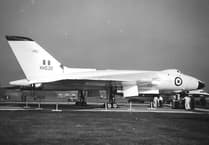70th ‘birthday’
One of the most popular Young Farmers Club in Pembrokeshire this month marks the 70th anniversary of it’s founding.
Every YFC is unique and Martletwy is no exception. Some like to help out in the local community, some love to take part in competitions and others want to travel.
Overall the members claim that their movement - part of a Worldwide association - is a dynamic and accessible bilingual rural youth organisation that helps and supports young people to become successful farmers, confident individuals, effective contributors and responsible citizens.
In Wales alone, the movement has 157 clubs and over 5,000 members aged between 10 and 26 years and all are affiliated to one of 12 independent county federations and are ran by a network of volunteers, supported by a varying staff team at a county level, depending on funding and membership numbers.
Ably supported and greatly encouraged since 1947 by excellent club leaders and enthusiastic ex-members the Martletwy club can reflect with very great pride on their remarkable record of achievements and the essential role which everyone has played in support of the community.
Many can reflect with happy memor’” which almost raised the roof of the decaying WI hut at Cresselly and it was the YFC who took it upon themselves to draw in generous sponsors and raise a huge some of money to provide an impressive new building with all modern facilities worthy of the locality.
Members have also organised a very well-supported agricultural show each summer and even put ran to ploughing matches at one stage
Very well done Martletwy members and may your outstanding successes long continue.
The first YFC Club was formed in 1929 in the then cross county border village of Clynderwen, with the Wales Federation established in 1936.
Was he or wasn’t he?
As people across the world today prepare to celebrate the life of one of the world’s most famous Irishmen, was St. Patrick actually Welsh?
For many, St. Patrick’s Day commemorations centre around pub crawls and street parades but, in one small west Wales village a more sedate celebration is likely to be taking place.
Patrick, or Padrig in Welsh, was born around 387 AD and was known as Maewyn (Welsh for devoted friend) Succat (a Pagan term for warlike).
He is believed to have come from Bannavem Taburniae (which could be Banwen) in the Neath valley where every year a service is held in his honour.
The annual event usually sees a small collection of residents, historians and school children congregate beside a plaque left in memory of the patron saint of Ireland, before they retire to a community centre for a cup of tea.
St. Patrick is remembered across the world for his missionary work in Ireland.
Although it is much lower key than many other St. Patrick’s Day celebrations, residents believe it is important to keep alive the link with Patrick - who would be their most famous son?
One man who had a personal interest in promoting the connection was author and historian, George Brinley Evans, who is on record as saying: “My grandfather had a smallholding by the side of the road which he farmed. When I was about eight-years-old, I was told St. Patrick was born on that land.
“It has been said for years he came from Banwen, and in 2004 we mounted a beautiful stone by the roadside to mark this -people even came from Ireland to visit it.
“Academics have looked at the idea that St. Patrick was born in Wales. Although you can’t really say he was a Welshman because it was Roman Britain,” he added.
While there is no firm evidence to prove St. Patrick was Welsh - with Scotland also mooted as his birthplace - some argue that several things point to it.
Another Banwen historian, Tom Marston said: “No tessellated Roman villa or plaques saying he was born here have been found but, for me, it is a line of wordplay in The Confession of St. Patrick, I quote: ‘I was picked a stone out of the bog,’ the word stone being a play on his name Patrick and bog being a play on the name of birthplace Banwen.
“I think the strongest evidence is the persistence of the notion among local people that it was so. Next is the written confession of the man himself where he mentions the name and description of his birthplace itself.
“But for me, it is a line of wordplay in The Confession of St. Patrick, I quote: ‘I was picked a stone out of the bog,’ the word stone being a play on his name Patrick and bog being a play on the name of birthplace Banwen.”
It is claimed that St. Patrick’s father, Calpurnius, was a ‘decurion’ - a kind of town councillor and a church deacon and his grandfather, Potitus, was a priest. He had lived in a villa with servants and helped in the fields until the age of seven when he was sent to school - later abducted and forced into slavery for six years as a teenager.
As a teenager, St. Patrick was said to have been captured by pirates, along with his sister, and sold into slavery. He then, supposedly, worked as a shepherd in Ireland until he managed to escape and board a ship home.
He is also said to have been ordained as a priest before returning to Ireland where he played a significant role in converting the country to Christianity, becoming its first bishop.
The training he received to do this missionary work is, again, said by some to have taken place in Wales at the Church of Llantwit Major.
Founded in 500 AD by the Welsh monk Illtud, the Church of Llantwit Major, or Llanilltud Fawr, is believed to be Britain’s earliest centre of learning.
St. Illtud established a monastic school of over 1,000 pupils, which is said to have included Wales’ patron saint St. David, as well as St. Patrick.
The Rector of Llantwit Major, Huw Butler, said: “It is traditionally said that Patrick studied in Llantwit, but I think it is highly unlikely that he did.
“It was the first seat of learning when it was established, and many ecclesiastical students were travellers who moved around extensively, so it is hard to know who actually did study here.
“There is a stained glass window which features St Patrick, but St. Illtud established the school here in 500 and Patrick died before this.”
Despite the lack of firm evidence of his Welsh connections, St. Patrick will be remembered this year, as he is every year, by locals in the village which has claimed him as its own.
George Brinley Evan added: “I hope every year more and more people learn about the fact St. Patrick was born in Wales, and more and more people come and visit.”
St. Patrick is remembered across the world for his missionary work in Ireland.
Childbirth at 65
With all the new technology regarding fertility recently, a 65-year-old friend of mine was able to give birth. When she was discharged from the hospital and went home, I went to visit.
‘May I see the new baby?’ I asked
‘Not yet,’ she said. ‘I’ll make coffee and we can chat for a while first.’
Thirty minutes had passed, and I asked, ‘May I see the new baby now?’
‘No, not yet,’ she said.
After another few minutes had elapsed, I asked again, ‘May I see the baby now?’
‘No, not yet,’ replied my friend.
Growing very impatient, I asked, ‘Well, when can I see the baby?’
‘When he cries!’ she told me.
‘When he cries?’ I demanded.
‘Why do I have to wait until he cries?’
‘Because I forgot where I put him - OK?’
(Contributed).





Comments
This article has no comments yet. Be the first to leave a comment.